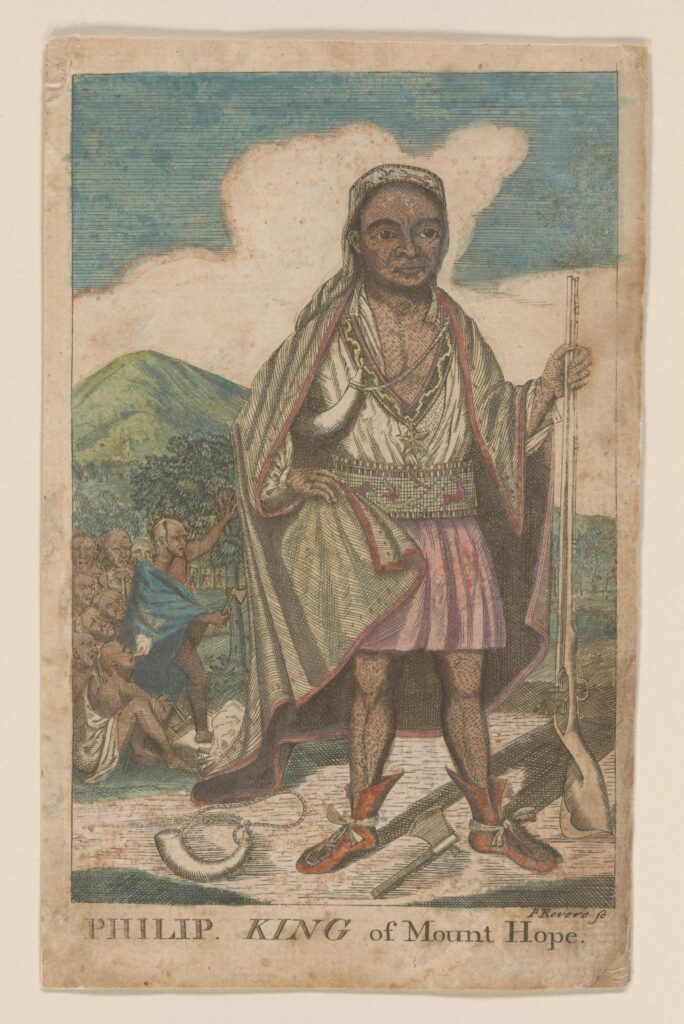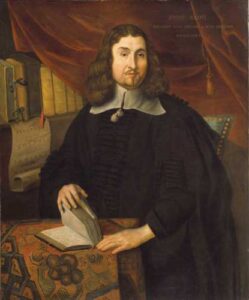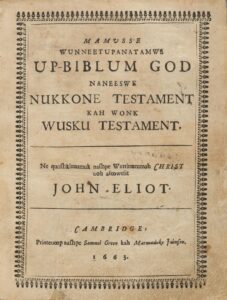
This essay is part of a new Westborough History Connections series called, “A Meeting of Two Cultures: Native Americans and Early European Settlers in Westborough.” Click here to start at the beginning of the series.
Early Relations, Praying Towns, and War
“Savages we call them, because their manners differ from ours, which we think the Perfection of Civility; they think the same of theirs.”
—Benjamin Franklin, “Remarks Concerning the Savages of North America” (1784)
Benjamin Franklin recognized that when two cultures judge one another, each one brings its own attitudes and perceptions about human behavior to its assessment. What makes contact between Native Americans and Europeans so fascinating is that for the first time in human history, two groups of people who had no contact with each other or with any other neighboring group for thousands of years suddenly came face-to-face. If we ever want a real-life example outside of science fiction of what could happen when two completely different civilizations suddenly confront one another, this is it!
Around 5,000 to 6,000 Nipmucs were living along rivers and streams connected to the Blackstone, Quaboag, Nashua, and Quinebaug Rivers when the Pilgrims landed in Plymouth in 1620. First contact between the Nipmuc and the English probably occurred in Sterling, MA in 1621, and their relationship with one another was initially friendly. Any recording of Nipmuc activity or behavior by the English, though, was piecemeal. The English never really developed any true understanding of the motives or experiences of their indigenous neighbors—they just weren’t that interested—and so such insight is lost to us as well.
We do not know how centralized political leadership was among Native American tribes in Massachusetts before European arrival. The Wampanoag Nation may have been created after local Native Americans, who up until this time had lived separately next to one another, saw a need to coalesce together in response to European disease and encroachment on their land. In 1675, Metacom (also known as King Philip) led a rebellion against English occupation by banding together several major tribes in and around Massachusetts—a rebellion that became known as King Philip’s War (1675-1678). Metacom was born around 1640, so unlike his grandparents who faced disease and European advancement on their land head on in the 1610s, he never experienced a world without Europeans. He lived in relative material prosperity and considered himself the equal of any Englishman. Metacom had always lived in, and hence had learned to navigate, the bicultural world of the mid-seventeenth century.
Conflict at this time was not solely between Native Americans and European colonizers. Until recently, our tendency in recounting this time and place in history is to put Europeans at the center of the narrative and pretend that the central drama was in how Indians progressively lost their land to these new arrivals. The construction of this narrative is perhaps understandable, since the historical sources we have do not provide much detail about Native American life before or during this time. But with a little reflection, we can easily see that this story does not adequately cover the way these actors experienced their times. As human beings, Native Americans of course had their own patterns of historical dynamics, population movements, politics, and cultural change—patterns that had been at play well before European arrival. Once Europeans landed, the newcomers automatically became players in Native American inter-tribal dramas, where many tribes tried to use the appearance of these outsiders to their own advantage.
Native Americans continually reached out to the English to acquire their goods and to tap into any power they may possess that could prove to be useful. They also constantly tried to form alliances with the English—despite their alien ways and manners—to help throw any balance of power their way in tensions with other tribes. But if in these alliances Europeans proved to be more dangerous than advantageous, Native Americans would just as easily encourage them to go and bother their neighboring rivals instead.
To use the implication of our science fiction analogy from above, the situation in North America is as if aliens descended on earth and then the U.S. and other Western nations tried to court them into an alliance against Russia and China to bolster our political position (and vice versa)—yet in the end the aliens end up taking over the entire planet. From the alien’s perspective, planetary conquest is the main story line in such a history because they would have had little interest in the squabbles between earthly nations before their arrival. But for we humans, our historical narrative would instead focus on the insertion and role of the aliens in the geopolitics of our time before they ended up taking control of the world. To return to our real-world scenario, the alien Europeans were more interested in how North America could suit their own needs than in understanding the history of Native American relations before their arrival, and since this history was never recorded, we are left to speculate on what it was based on the scant evidence available to us today.
* * *

Not long after John Eliot arrived in Natick, MA in 1651 to recruit members of the Nipmuc tribe to form “praying town” communities, native people in New England were already living alongside 60,000 English colonists. Eliot’s towns were designed as tightly controlled environments that regulated Christian morality and encouraged Indians to adopt a European work ethic, raise livestock, become sedentary, and follow the Christian God. Eliot educated them to read the Bible, and recruited preachers and teachers among the Nipmuc to help bring more people from the tribe into their fold. In short, he wanted to turn the Nipmucs into Europeans, as well as to turn them into productive laborers for colonial markets. Some of the Nipmucs went on to attend Harvard Indian College where they mastered English, Latin, and Greek. James Printer, one of these Nipmuc scholars, set the type on the first Bible published in North America.

By the time King Philip’s War broke out in 1675, around 2,300 Native Americans were living in Eliot’s praying towns, which were spread throughout Massachusetts Bay, Plymouth, Martha’s Vineyard, and Nantucket. Some of the Nipmuc joined Metacom’s forces, while Eliot’s praying Indians became fighters and scouts for the English. Nonetheless, the colonial government feared that the praying Indians would join Metacom, and so they confined them to five plantations: Natick, Nashobah (Littleton), Punkapoag (Canton), Wamesit (Tewksbury), and Hassanamesit (Grafton). If any of these praying Indians were found outside of these limits, they would be subject to jail or death.
The intricacies of King Philip’s War are too complicated to cover in this newsletter (you can consult the Native American Resources in the WPL for book suggestions if you are interested), but here are a few notable observations. Even though Native Americans fought against the English with the aim of kicking them out of the territory, the war was not between two groups of strangers, but between neighbors. By this point, the two groups had been trading, working, negotiating, and, in some cases, attending school and church together. Leading up to the war, Native Americans had sought cooperation and coexistence on shared land; they were not interested in forming a frontier that kept the two groups apart from one another. In fact, Metacom thought he could use the presence of the English to build on his tribes’ unprecedented wealth accumulation. The notion that Native life was incompatible and opposed to English interests was a belief held by the colonists, not the Native Americans, who instead sought flexibility in living together side-by-side.
Metacom was killed in 1676, and the war named after him ended in 1678. Nipmucs who had fought against the English were either killed, sold into slavery, or went into hiding with tribes in the north and west of where they used to live. Others returned to their praying town sites to resettle, but many of them left or were forced out as more English settlers moved in. Some among this group adopted English habits and dress and made a living by selling baskets, brooms, and herbs to settlers.
The wars among the British, French, and Spanish powers in North America in the seventeenth century were not simply European. They were also Native American and involved Inter-Indian as well as Indian-colonial rivalries where Native Americans had just as much at stake as the Europeans. Taken together, these wars were a complex process of working out an equilibrium among European imperial powers and among various groups and alliances of Native Americans. Loyalties ebbed and flowed (and sometimes conflicted) in figuring out control and coexistence in eastern North America.
After the War of the League of Augsburg (a.k.a., “King William’s War,” 1689-1697) and the War of the Spanish Succession (known in the U.S. as “Queen Anne’s War,” 1702-1713)—wars that are usually lumped together now as the “French and Indian Wars”—British America became remarkably politically stable between 1720 and 1750. Relative economic prosperity through this time certainly helped, as the expanding British Empire brought tea, coffee, sugar, rum, dishware, and other luxury goods that were normally confined to the aristocracy into the colonies. This new prosperity also attracted new immigrants from Germanic principalities, Ireland, and northern Britain.
In a way, competition in North America among European powers within the context of Native American interests and rivalries created conditions where both European and Native peoples could potentially live next to one another. If one group became too powerful, a shift in loyalty by one of the groups could put the balance back in order. But British victory in the Seven Years’ War (1756-1763) reoriented geopolitics throughout the world, and the effect on North America was no exception. Now, complete British victory in this global conflict put North American power mainly in England’s hands. Devoid of competition from any other European nation, this situation eventually made the British-American people so confident in their ability to govern themselves that they claimed the right to secede from the British Empire and started the American Revolution. Consequently, Indian and European coexistence in the colonial world that was the norm for over two hundred years was erased from historical memory. Going forward, the historical narrative would instead focus on the alien invaders, in this case the English, and their triumphal formation of a new American nation.
Lest we forget, though, as historian Pekka Hämäläinen points out, America remained “overwhelmingly Indigenous well into the nineteenth century.” Control over the North American continent was essentially a four-centuries-long war against Native Americans who fiercely resisted it. Gone were the days when Native Americans and Europeans could potentially have learned how to live next to one another peacefully.
—Anthony Vaver, Local History Librarian
Works Consulted:
* * *

Nature Notes
We sure have had a wet summer!
According to Annie Reid, we also had a wet summer back in 2013, when we experienced a proliferation of the square-stemmed monkey-flower, a native wildflower that enjoys wet areas. I’m guessing that this wild flower is running rampant this year! Put on your galoshes and see if you can find it, and while you are at it, discover even more about Westborough’s natural surroundings during this time of year in Reid’s Nature Notes for August.
* * *
History Corner
Look for me and other Westborough residents with an interest in history at Westborough Connects’ “Westborough for Life!” program on Sunday, September 10 from 1:00 p.m. to 4:00 p.m. at the Westborough High School. We will be putting together a “History Corner,” where you can stop by to learn and ask questions about Westborough’s past.
* * *
Did you enjoy reading this Westborough Center Pastimes newsletter? Then subscribe by e-mail and have the newsletter and other notices from the Westborough Center for History and Culture at the Westborough Public Library delivered directly to your e-mail inbox.
You can also read the current and past issues on the Web by clicking here.

